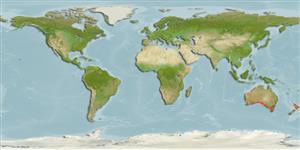Common names from other countries
分类 / Names
俗名 | 同种异名 | Catalog of Fishes(属, 种) | ITIS | CoL | WoRMS | Cloffa
Environment: milieu / climate zone / depth range / distribution range
生态学
海洋; 半咸淡水 居于水底的; 深度上下限 1 - 100 m (Ref. 9563). 溫帶; 30°S - 43°S
Indo-Pacific: known only from southern Australia.
印度-太平洋: 已知只來自澳洲南部了。
Length at first maturity / 大小 / 重量 / 年龄
Maturity: Lm 23.5 range ? - ? cm
Max length : 46.0 cm TL 雄鱼/尚未辨别雌雄; (Ref. 9563); 最大体重: 3.1 kg (Ref. 6390)
简单描述
型态特徵 | 形态测量图
脊椎骨: 18 - 20. This species differs from Platycephalus westraliae in having the following characters: both second dorsal and anal fin rays usually 14 (vs. 13), total gill rakers 18-20 (vs. 10); palatine with a tooth band comprised of several irregular rows of conical teeth (vs. with an inner larger conical and an outer smaller villiform tooth rows); caudal fin with several small pale brown spots on the upper lobe and one or two large dark brown or black spots on the lower lobe, and with concave posterior margin (vs. with 3 dark bands and with mostly straight posterior margin) (Ref. 86914).
Inhabit coastal waters from shallow bays and inlets to depths of about 100 m over sand, shell grit and mud substrates (Ref. 6390). Sand flathead are usually solitary but may form loose aggregations (Ref. 2165, 27247). They sometimes move long distances (Ref. 6390). They are active foragers and ambush predators (Ref. 6390), occasionally are scavengers (Ref. 6390). Feed on crustaceans and fish (Ref. 2165). Its fin spines are venomous, can inflict mild to severe pain (Ref. 125684).
栖息于来自浅湾与小水湾的沿岸水域在沙子,贝壳砂砾与泥底部上的到深度大约 100 公尺。 (参考文献 6390) 沙子牛尾鱼是通常独居性的但是可能形成松散的鱼群.(参考文献 2165,27247) 他们有时长距离移动。 (参考文献 6390) 他们是活跃的抢劫者与埋伏掠食者。 (参考文献 6390) 他们也是偶然的清道夫。 (参考文献 6390) 捕食甲壳类动物和鱼类。 (参考文献 2165)
Life cycle and mating behavior
成熟度 | 繁殖 | 产卵场 | 卵 | 孕卵数 | 仔鱼
印度-太平洋: 已知只來自澳洲南部了。
Paxton, J.R., D.F. Hoese, G.R. Allen and J.E. Hanley, 1989. Pisces. Petromyzontidae to Carangidae. Zoological Catalogue of Australia, Vol. 7. Australian Government Publishing Service, Canberra, 665 p. (Ref. 7300)
CITES (Ref. 128078)
Not Evaluated
人类利用
渔业: 商业性
更多信息
参考文献养殖养殖信息品种遗传学Electrophoreses遗传率疾病加工Mass conversion
合作者照片Stamps, Coins Misc.声音神经毒速度泳型鳃区Otoliths脑重体重比眼睛色素
工具
特别资料
下载 XML
网络资源
Estimates based on models
Preferred temperature (Ref.
115969): 14.6 - 18.5, mean 17.1 (based on 242 cells).
Phylogenetic diversity index (Ref.
82804): PD
50 = 0.5000 [Uniqueness, from 0.5 = low to 2.0 = high].
Bayesian length-weight: a=0.00490 (0.00381 - 0.00630), b=3.06 (2.98 - 3.14), in cm Total Length, based on LWR estimates for this species (Ref.
93245).
营养阶层 (Ref.
69278): 4.3 ±0.75 se; based on food items.
回复力 (Ref.
120179): 中等的, 族群倍增时间最少 1.4 - 4.4年 (K=0.19; tmax=9).
Fishing Vulnerability (Ref.
59153): Low to moderate vulnerability (29 of 100).
